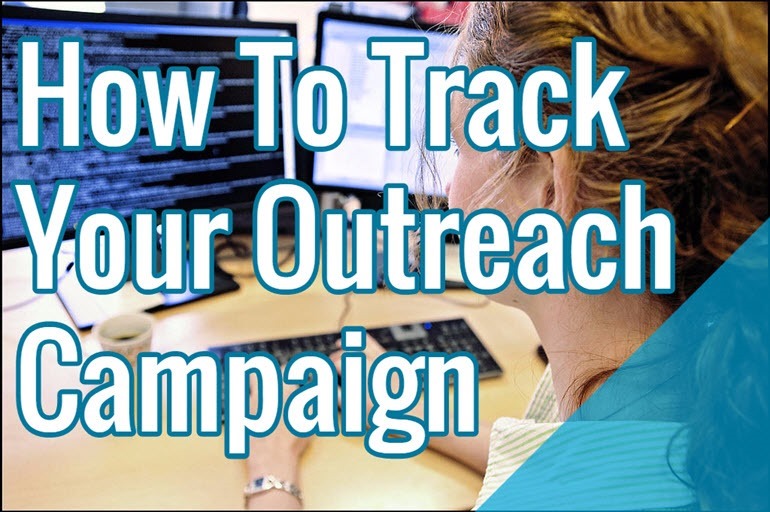
If you’re running a marketing campaign you need to start tracking your metrics.
I know – it’s annoying.
The thing about tracking metrics is, at first glance, it doesn’t seem like it’s going to improve the campaign.
Afterall, the emails are already sent – so why does tracking matter?
Three reasons:
Reason #1: Tracking your metrics will help you know when and with whom to follow up, which has been shown to increase your success rate substantially (more on this later).
Reason #2: If you plan on running future marketing campaigns (most people do), then in order to improve you will want to know what worked and what didn’t.
Reason #3: In order to judge the ROI on your time, you’re going to want to start tracking the results.
So now that you understand the “why”, let’s get into the “how”!
What Am I Tracking & Testing?
Before you get started you should think about what tests you want to implement in your outreach campaign.
To keep it simple, in this campaign we’re focused purely on email, so we’re only testing templates, but I’ll talk about additional tests you can do later.
What Templates Got The Highest Open Rate?
Half the battle of outreach is just getting someone to open your email.
Often, that starts with the subject. Testing different subject lines is key, which is why we want to know the open rate.
The open rate is defined as:
Number Of Opens / Number Of Sent Emails
When you find the highest open rate hold on to that subject line and use it in your next campaign, then try completely different subjects than before.
Although you should know that “the best subject line” always depends, here’s some best practices to get you started.
What Templates Got The Most (Positive) Replies
Opens are great, but they don’t guarantee an end of the funnel conversion. In this case it’s a reply, but not just any reply, a positive reply.
Therefore we want to see which templates produced the highest reply rate.
The reply rate is defined as:
The Number Of Replies / Number Of Sent Emails
If you find out that one email got a higher reply rate, but not the highest open rate, you have a great test for the next outreach campaign in which you can combine the message body of the reply rate winner with the subject line of the open rate winner.
However, know that the open rate and the reply rate are not mutually exclusive, so don’t just assume combining them will always result in the best template.
Like subject lines, message body is very unique to the campaign, but here are some templates to jog your creative juices.
What Metrics Should Your Track?
It’s possible to go way overboard on metrics. When I run outreach campaigns I try to stick to the basics. Here’s what I’m looking at:
- Who You Contacted
- When You Contacted Them
- Which Template You Used
- Did They Open The Email?
- Did They Reply To The Email
- Did They Click A Link In The Email
- When Did They Reply
As you can see I’m including the basic metrics necessary for the tests I want to run.
Now, you want to to track whether or not certain actions were taken, and importantly, when were they taken.
Why – when?
The when is going to inform the follow up, which is critical to improving your response rate.
How Many People Do I Need In Each Test?
Statistics is not something to be taken lightly.
There are legitimate formulas that you can use to tell if there is a statistically significant difference between two tests.
As a general rule of thumb I like to include at least 100 people in each test cell.
What Tools Should You Use To Track?
Alright, so you have some neat metrics to track and tests to run. How should you go about it?
It really depends on your preference. There are of course free tools that you can use to manage the campaign, but they are not going to help you get things like Open Rate or Click Rate, and they aren’t meant to be full on CRMs.
For those you will need more robust tools which have that kind of tracking built in.
I’ve included several well known ones below.
Free Tools
- Excel
- Google Docs
Freemium Tools
Premium Outreach CRMs
How Do You Know If You Should Follow Up?
Ah the follow up.
I’ve read numerous case studies in which following up played a critical role in improving the response rate, such as this one about a 333% improvement in a cold outreach campaign.
According to that same article you should be following up 6 times.
That decision is entirely up to you (and perhaps something you should test).
Regardless, I like to follow up at least twice with anyone who doesn’t respond.
- One after 3 days
- One after 7 days
After that, I’ve been known to throw in the towel.
Other Ideas For Tests
We only discussed a few basic tests to get started, and that’s because if you’re only dealing with email templates it’s relatively limited as to what you can test.
However if you’re willing to introduce some other actions, the sky’s the limit.
Engagement
For example, you can combine your outreach with different attempts at engaging with the prospect, such as:
- Commenting on their blog
- Tweeting at them
- Following them on social media
You can divide the population into cells and see if these engagement tactics increase your success rate to justify the extra time it takes.
Personalization
Another frequently talked about test is to add more personalization to the outreach email. Sure, you can start with basic custom fields, but you can also spend more time referencing a recent article you read by them or leverage whatever else you know about them to see if this helps improve your response rate.
Follow Ups
Naturally you can test different follow up sequences as well. Not just what is sent but when it’s sent, or also based on what action was taken (for example, send one follow up series for a click and one for an open). This type of logic based testing is relatively complex, but doable.
Different Populations
If you have different populations as part of your outreach, you can split them into different cells and feed them the exact same outreach sequence to see how they respond.
This is very useful if you are getting your prospects from different sources, and you want to understand if they’re different.
Conclusion
With everything I’ve done in business and in life, I always see the most improvements when I implement tracking.
I’ve brought it offline into things like fitness and nutrition and seen it work wonders. The same is true for marketing.
How are you going to track your next outreach campaign?
Now Read:
- What is Outreach and how can a Common Business Owner do it
- How To Do Blogger Outreach: The Strategy, Knowledge, and Tools
- How To Execute A Killer Outreach and Link Building Campaign
Next Steps:
- What is Outreach and how can a Common Business Owner do it
- How To Do Blogger Outreach: The Strategy, Knowledge, and Tools
- How To Execute A Killer Outreach and Link Building Campaign
Hand-Picked Related Articles:
- What is Outreach and how can a Common Business Owner do it
- How To Do Blogger Outreach: The Strategy, Knowledge, and Tools
- How To Execute A Killer Outreach and Link Building Campaign
* Lead image adapted from European Parliament
How To Track Your Outreach Campaign
The post How To Track Your Outreach Campaign appeared first on Search Engine People Blog.
(184)
Report Post






